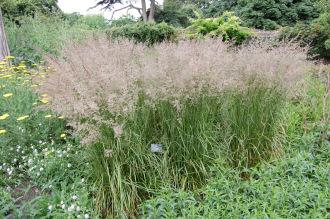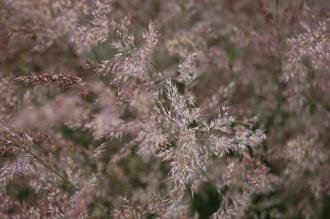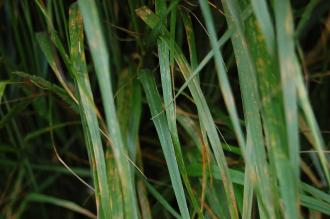
Calamagrostis x acutiflora ‘Karl Foerster’ (02/07/2016, Kew Gardens, London)
Position: Full sun to partial shade
Flowering period: Summer
Soil: Moist, well drained
Eventual Height: 1.5m
Eventual Spread: 75cm
Hardiness: 5a, 5b, 6a, 6b, 7a, 7b, 8a, 8b, 9a
Family: Poaceae
Calamagrostis x acutiflora ‘Karl Foerster’ is a deciduous perennial grass with an upright, clump forming habit. Its mid green leaves are strap shaped and are up to 90cm long and 15mm across. Its pink/ purple flowers appear in the form of dense feathery spikes which are up to 35cm long. Its flowers are followed by light brown seeds which persist on the plant during the winter months. Its roots are rhizomes which aids its spread.

Calamagrostis x acutiflora ‘Karl Foerster’ Flower (02/07/2016, Kew Gardens, London)
Calamagrostis x acutiflora, commonly known as Feather Reed Grass, is a cross between Calamagrostis arundinacea and Calamagrostis epigejos.
The etymological root of the binomial name Calamagrostis is from the Greek Kalamos meaning ‘reed’ and agros meaning ‘field’. Acutiflora is derived from the Latin acutus meaning ‘cut to a point’ and flora in reference to the Roman Goddess of flowering plants.
The landscape architect may find Calamagrostis x acutiflora ‘Karl Foerster’ useful as part of a prairie type planting scheme. Due to its tollerance of dry and wet soils it is suitable for use in ‘rain gardens’.

Calamagrostis x acutiflora ‘Karl Foerster’ Leaf (02/07/2016, Kew Gardens, London)
Ecologically, Calamagrostis x acutiflora ‘Karl Foerster’ seeds are attractive to some birds during the winter months.
Calamagrostis x acutiflora ‘Karl Foerster’ prefers moist, fertile, well-drained soils. It tolerates most pH of soil. This grass will tolerate wet soils.
Calamagrostis x acutiflora ‘Karl Foerster’ requires little maintenance. Large clumps may be divided in spring.

Landscape Architecture

